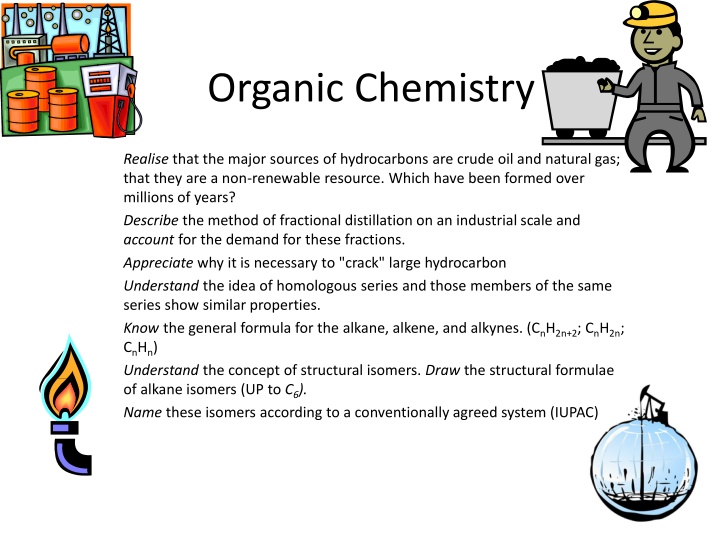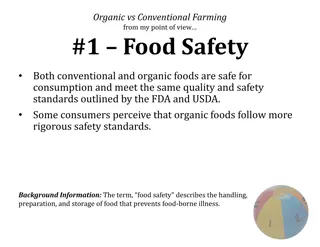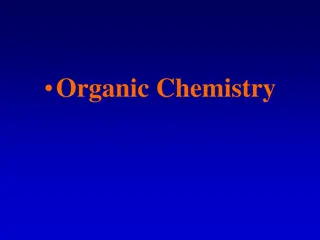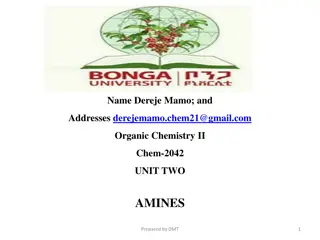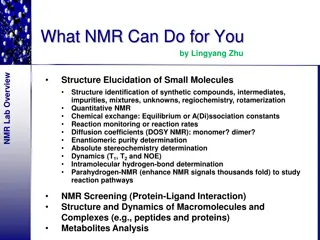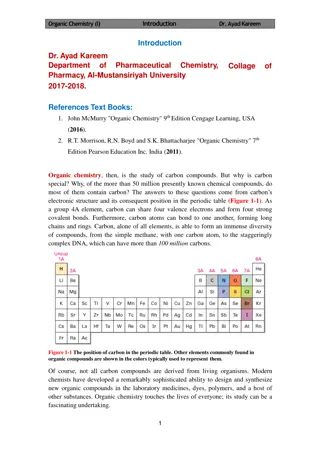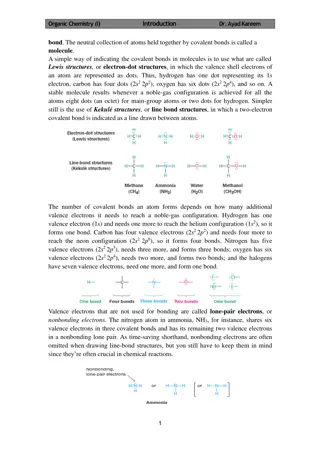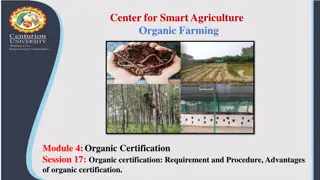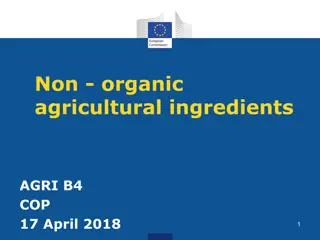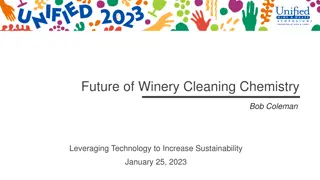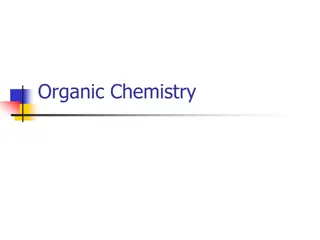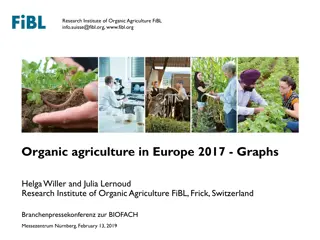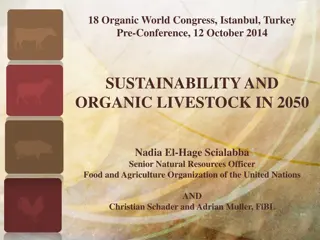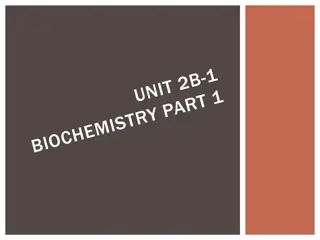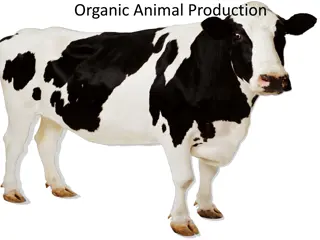Organic Chemistry
"Major sources of hydrocarbons like crude oil and natural gas are non-renewable resources formed over millions of years. Learn about the industrial-scale method of fractional distillation and the demand for its fractions in various industries."
Download Presentation

Please find below an Image/Link to download the presentation.
The content on the website is provided AS IS for your information and personal use only. It may not be sold, licensed, or shared on other websites without obtaining consent from the author.If you encounter any issues during the download, it is possible that the publisher has removed the file from their server.
You are allowed to download the files provided on this website for personal or commercial use, subject to the condition that they are used lawfully. All files are the property of their respective owners.
The content on the website is provided AS IS for your information and personal use only. It may not be sold, licensed, or shared on other websites without obtaining consent from the author.
E N D
Presentation Transcript
Organic Chemistry Realise that the major sources of hydrocarbons are crude oil and natural gas; that they are a non-renewable resource. Which have been formed over millions of years? Describe the method of fractional distillation on an industrial scale and account for the demand for these fractions. Appreciate why it is necessary to "crack" large hydrocarbon Understand the idea of homologous series and those members of the same series show similar properties. Know the general formula for the alkane, alkene, and alkynes. (CnH2n+2; CnH2n; CnHn) Understand the concept of structural isomers. Draw the structural formulae of alkane isomers (UP to C6). Name these isomers according to a conventionally agreed system (IUPAC)
Fossil Fuels Plants make their food by photosynthesis; transforming the sun s energy into carbohydrates, such as glucose. Normally the plants then die and decay, or are eaten by animals. The carbohydrate in the plant is oxidized and converted back to carbon dioxide and water However, sometimes the plants die and decay in anaerobic conditions (in the absence of air). Without the air the carbohydrate is unable to oxidize to carbon dioxide and water. The plant undergoes anaerobic decay over thousands of years and the plant is converted into hydrocarbons. Fuels formed this way are called fossil fuels. When they are burned (combusted) they form carbon dioxide and water. They are releasing the stored energy from the sun!
Fossil Fuels The hydrocarbons are a mixture of liquids and gases that slowly leaked out of the sedimentary source rocks into the porous rocks above. These reservoir rocks hold the liquid oil and natural gas.
Fractional Distillationhttp://www.youtube.com/watch?v=VofKBcdZtjo&feature=related The crude oil (petroleum) is a black liquid, which is a mixture of many different hydrocarbons. It has to be purified and separated into different fractions. This is done in oil refineries in a process called fractional distillation. How does fractional distillation work? Fractional distillation is a very simple technique: - it works on the same principle as distillation except that crude oil contains many different substances; each has its unique boiling point (volatility), some are readily vaporized whilst others have much higher boiling points.
The Fractions and their uses Fraction Carbon atoms in molecule Boiling range / C Uses Fuel gas, LPG, Refinery Gas 1-4 -160to 20 C Methane gas fuel for cooking, propane gas in bottles Gasoline, Petrol 5-11 20to 60 C Easily vapourised, highly flammable, easily ignited, car fuel Naphtha 7-13 60- to 80 C Not much use as a fuel, excellent chemical feedstock once cracked Paraffin, kerosene 10-16 120 to 240 C Domestic heater fuel, jet fuel Diesel oil, Gas Oil 15-25 220 to 250 C Car and heavy vehicle fuel Fuel Oil, lubricating oils & Waxes 20-70 250 to 350 C Not esily evaporated, not as flammable, safe to store, lubricating oils, clear waxes and polishes Bitumen Over 70 Over 350 C Tough resistant adhesive, used as waterproofing material and road surfaces
Cracking and Homologous series Process allows us to make crude oil useful; each fraction contains a range of hydrocarbons. These hydrocarbons can be divided into different homologous series. Homologous series is a group of organic compounds with similar chemical properties and general chemical formula. However, there is a gradual change in their physical properties; i.e. their boiling points and melting points change; they go from being gases to solids. The homologous series we will be concentrating on are called Alkanes and Alkenes. They can be obtained by further refinement of the fractions. This process is called cracking.
Alkanes CnH2n+2 The bond between atoms are all single. The bonds between atoms are strong but the bonds between molecules are weak. CARBON CARBON UNREACTIVE BONDS CARBON HYDROGEN
Properties 1. Good fuels: - lots of heat energy made - COMPLETE COMBUSTION H2O + CO2 - Short chains are best (cleaner + less energy to break) 2. Do not dissolve or react with water or reactants dissolved in water: - no energy to break the unreactive C-C or C-H bonds. 3. Oily 4. CRACKING produces short chains and an alkene from long chain alkanes: - Long chain HC (Thermal decomposition) Shorter chain HC+ Alkene 5. React with Bromine and Chlorine (alkane + halogen): - chain reaction as FREE RADICALS are made - continued chlorofluorocarbons (refrigerants) + coolants/solvents - SUSTITUTION REACTION as each H atom in hydrocarbon is replaced by the halogen
Examples: H Methane CH4 H H C H H H Ethane C2H6 H H C C H H
Alkenes CnH2n A by-product of CRACKING an Alkane Used for making polymers C=C is more reactive than C-C The molecule is unsaturated and the double bonds allow addition polymerisation. H H Ethene C2H4 C C H H
Isomerism When two or more compounds have the same chemical formula but different structures. Remember that: Carbon forms 4 bonds Hydrogen forms one bond Oxygen forms two bonds
Butane What homologous series does it belong to? If n=4 what is the chemical formula? How many different structures can you make?
Pentane What homologous series does it belong to? If n=5 what is the chemical formula? How many different structures can you make?
Octane What homologous series does it belong to? If n=8 what is the chemical formula? How many different structures can you make?
Alkenes Alkenes are a family of hydrocarbons (compounds containing carbon and hydrogen only) containing a carbon-carbon double bond. If you look at the naming you will see that it is similar to alkanes. The prefix Eth-, prop-, but-, pent-, hex-, hept-, oct-, non-, and dec- are the same. However, the suffix is ene! You can work out the formula of any of them using: CnH2n; this is different from alkanes which are CnH2n+2 Name Structure Ethene C=C Propene C=C-C Butene C=C-C-C Pentene C=C-C-C-C
Reactions of Alkene The important reactions centre on the double bond. Alkenes undergo addition reactions. For example, using a general molecule X-Y . . . The rather exposed electrons in the double bond are particularly open to attack by things which carry some degree of positive charge. These are called electrophiles.
Alkene Isomers All the alkenes with 4 or more carbon atoms in them show structural isomerism. This means that there are two or more different structural formulae that you can draw for each molecular formula.
Addition Polymerisation http://www.youtube.com/watch?v=YzGZl-J0wWQ&feature=related All alkenes will react with free radical initiators to form polymers by a free radical addition reaction. Some definitions monomer - a single unit e.g. an alkene. free radical initiator - a compound that starts a free radical reaction by producing radicals. Polymer- a material produced from many separate single monomer units joined up together. An addition polymer is simply named after the monomer alkene that it is prepared from. The general formula of an alkene momer-R means any group of atoms, e.g. R= Cl for chloroethene.
Name the Polymers Polymerise the following monomers phenylethene Ethene Propene methyl methacrylate chloroethene
Thermosoftening and Thermosetting Polymers Properties of some polymers Thermosoftening Polymers Thermosetting Polymer
Functional Groups Homologous series are a series of compounds with a similar general formulae, possessing similar chemical properties due to the presence of the same functional group. Functional groups are specific groups of atoms and/or bonds within molecules that are responsible for the characteristic chemical reactions of those molecules. The same functional group will undergo the same or a similar chemical reaction.
Examples of Functional Groups Alcohol Aldehyde Ketone Carboxylic Acid Esters Halogenoalkanes
Alcohols Naming/Structure Physical/Chemical Properties
